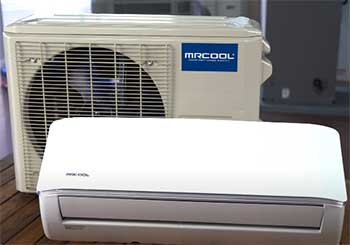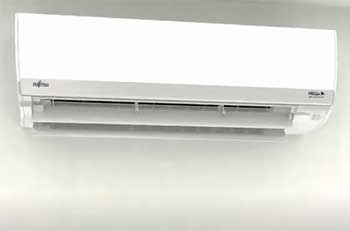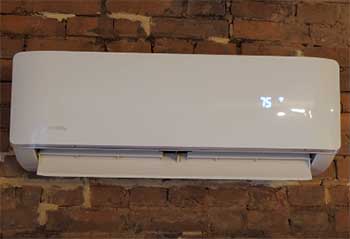Mini-split air conditioners are gaining popularity among homeowners looking for an efficient and customizable way to cool specific rooms in their homes. Two of the top brands in mini-split air conditioning units are MrCool and Fujitsu.
But which one is better for your needs?
Here we’ll compare the pros, cons, features, performance, reliability, and costs of MrCool and Fujitsu mini-split systems to help you decide.
A Brief Comparison Table
| Aspects | MrCool | Fujitsu | Winner |
| Ease of Installation | DIY-friendly | Professional installation required | MrCool |
| Efficiency Rating | 17-19 SEER | 19-26 SEER | Fujitsu |
| Noise Output | 42-49 dBA | 19-45 dBA | Fujitsu |
| BTUs Available | 9-36k BTU | 9-36k BTU | Tie |
| Warranty Length | 5-7 years | 5-10 years | Fujitsu |
| Smart Controls | Wifi, apps, display optional | Wifi standard, apps, display | Tie |
| Upfront Cost | $2000-$3000 | $4000-$8000+ | MrCool |
| Energy Usage | 17 SEER – $150/yr | 21 SEER – $100/yr | Tie |
| Availability | Online ordering, DIY | Authorized dealers only | MrCool |
| Appearance | Basic matte white | Sleek, modern, luxe | Fujitsu |
Overview of MrCool and Fujitsu

MrCool is a relatively new brand of mini-split units founded in 2011 that focuses on providing high-quality, affordable systems for DIY installation.
MrCool units are made in partnership with expert HVAC manufacturer Midea.
Fujitsu, on the other hand, is an established Japanese brand that has been making AC units since the 1960s.
They are known for their energy-efficient and innovative mini-split designs powered by advanced inverter compressors. Fujitsu pioneered inverter technology in mini-split systems.
So in summary:
- MrCool is a budget-friendly DIY brand while Fujitsu is a premium established brand.
- MrCool leverages Midea’s manufacturing expertise whereas Fujitsu has decades of its own experience.
- MrCool focuses on simplicity and value while Fujitsu emphasizes technological innovation and performance.
Key Differences Between MrCool And Fujitsu Mini-Split Air Conditioners
Now let’s do a detailed comparison of their features, performance, reliability and costs.
- Ease of Installation
One of the biggest advantages of MrCool mini splits is they are designed for DIY installation. The units come with pre-charged lines and condenser so no vacuum pump or refrigerant recharge is needed.
The condenser usually mounts on simple brackets on an exterior wall. All you have to do is mount the wall-mounted blower on the interior wall and connect the refrigerant lines and electrical wires. MrCool provides clear installation manuals and how-to videos.
In contrast, Fujitsu systems are more complicated to install and usually require professional help. The condenser needs to be wired to the blower motors and drained properly.
Refrigerant lines need to be cut, reflared, pressure tested and charged. Overall, Fujitsu units provide more customization flexibility in installation but require expert handling.
Winner: MrCool for its simpler DIY-friendly installation process.
- Efficiency and Performance
When it comes to energy efficiency and cooling/heating performance, Fujitsu systems are ahead of MrCool.

Fujitsu uses advanced inverter compressors that can modulate cooling capacity and airflow based on the current temperature.
This allows Fujitsu units to maintain precise temperatures while consuming 30-50% less energy than traditional compressors.
Fujitsu also has stepless motors in its blower units for more airflow control.
MrCool mini splits have fixed-speed compressors so they run at max capacity and then shut off once the room hits the target temp. They can’t fine tune their cooling output as well as Fujitsu inverter units. Most MrCool models have average SEER ratings of 17-19 vs Fujitsu’s 22+ SEER units.
Noise level is another performance metric to compare. Fujitsu systems use soundproofed indoor units rated at 19-45 decibels while MrCool units output around 42-49 decibels. So Fujitsu runs quieter.
Winner: Fujitsu for its leading efficiency ratings, inverter-driven climate control and lower noise.
- Range of Options
One area where MrCool excels is providing a wide range of options targeted at common homeowner needs. MrCool offers:
- 9k to 36k BTU unit sizes
- Single and multi-zone condensers
- Units optimized for garages, sunrooms, bedrooms etc
- 115v and 230v electrical units
- Concealed and wall mount blower options
- WiFi enabled smart controls
Fujitsu has an even wider range of offerings including:
- Compact cassette, ducted, and wall mount indoor units
- Indoor units ranging from 9k to 36k BTU
- Multi-zone units up to 5 indoor blowers
- Sophisticated humidity control
- Advanced filtration with ionizers
- Customizable louvers and vents
So when it comes to having the exact specifications for your space, Fujitsu wins for its huge catalog of mini-split options. But MrCool still covers the key configurations most homeowners need.
- Reliability and Durability
Fujitsu’s units are designed for long-term durability and performance. Their outdoor compressors have marine grade coatings and corrosion resistant fins to withstand harsh weather conditions. Meanwhile MrCool uses more standard materials like copper tubing prone to rust.
Independent tests show an average Fujitsu mini-split lasts over 15 years thanks to its robust components. MrCool’s shorter history makes longevity hard to judge but most units have 5-7 year warranties on parts.
When it comes to reliability, MrCool’s DIY-friendly units sometimes have refrigerant leaks or electrical issues from improper homeowner installation. Fujitsu’s professional installation minimizes these problems but their advanced components mean higher repair costs if something breaks.
Winner: Fujitsu based on proven durability, longer operating life and more reliable performance when properly installed.
- Warranties
The warranty coverage provides an indication of how much the company trusts its products.
MrCool units come with a solid 5 year warranty on all parts and 7 years on the compressor.
Fujitsu provides an impressive 10 year parts warranty plus 5-10 years on the compressor depending on the model.
Winner: Fujitsu for its industry-leading 10 year comprehensive warranty showing its confidence in reliability.
- Smart Controls and IoT Features
This category looks at the app control options and “smart” features built into the AC units.
MrCool units use MRCOOL smartphone apps to control temperatures, modes, schedules and more. Entry level units have basic manual knobs while higher end models have color touchscreen displays. The optional MRCOOL ComfortU kit provides smart climate control by sensing occupancy and modifying temps accordingly.
Fujitsu also offers advanced control kits called IntesisHome and Kumo Cloud to integrate their systems with home automation platforms like Google Home and Amazon Alexa. This allows voice and remote operation. Fujitsu’s Halcyon units have built-in WiFi for app controls without add-on kits needed. Many models also contain HD displays for local control and monitoring.
Winner: Tie. Both Fujitsu and MrCool offer competitive smart connectivity and management options.
- Upfront Costs
Now let’s compare the upfront equipment and installation costs.
MrCool mini splits range from $600 up to $2500 MSRP depending on the size, electrical specs and features. Because they are DIY, you avoid the added cost of professional installation. All said, a typical MrCool dual-zone system costs $2000 – $3000 with labor.
Fujitsu systems range from $1000 to $4000 depending on the efficiency ratings, zone configurations and options. But you should budget $4000+ in total installed costs since they require specialized labor for mounting, wiring, flaring, vacuuming, charging and testing the lines.
Multi-zone systems can cost upwards of $8000 fully installed.
Winner: MrCool has the clear advantage in initial purchase price and costs of ownership.
- Operating Costs
We also need to consider the long term costs in energy bills. SEER rating provides a proxy for yearly energy consumption.
The minimum SEER rating today is 14 SEER but higher is better. MrCool units range from 14-19 SEER. The most common DIY units are around 17 SEER.
Fujitsu mini splits are available from 16 SEER all the way up to 26 SEER for their top of the line units. Most models however are 19-22 SEER.
What does this SEER difference amount to in power costs?
- 17 SEER MrCool: ~$150 yearly power consumption
- 21 SEER Fujitsu: ~$100 yearly power consumption
So while Fujitsu units can save $50 or more per year in energy costs, keep in mind they cost much more upfront. The energy savings may take years to offset the higher purchasing price.
Winner: Tie. The running cost benefits depend on your existing HVAC unit’s efficiency.
- Homeowner Reviews
Looking at homeowner experiences helps reveal the real-world pros and cons.
MrCool garners positive DIYer reviews for its easy installation process, clearly labeled wires and refrigerant ports, and helpful instructional videos. Owners say their units effectively cool rooms quietly while still staying affordable.
Complaints cite occasional leaks requiring recharging the refrigerant.
Fujitsu earns praise for its whisper quiet operation, precise temperature control and sophisticated look. But most reviews caution about the complex installation that really requires a skilled HVAC pro.
Some also report reliability issues with leaks or malfunctions needing expensive service calls down the road.
Winner: MrCool based on better experiences among ordinary homeowners doing DIY installation.
- Availability of HVAC Technicians
Because Fujitsu units require professional installation and maintenance, having qualified HVAC techs familiar with the brand in your area is crucial. MrCool’s DIY-friendly design widens its accessibility to homeowners nationwide.
Fujitsu’s authorized dealer locator shows concentrated availability in metro areas and coastal regions with fewer options in the Midwest, South and rural locations. In contrast MrCool units can be shipped and purchased by any competent DIYer comfortable with basic electrical and mounting work.
Winner: MrCool for its broader accessibility through online sales and DIY model. Checking your local Fujitsu dealer network is advised.
- Visual Appearance

Aesthetics may play a role in your decision for a permanently wall-mounted AC system.
MrCool units have a basic appearance with plain matte white casings and minimal branding.
Screws are partially concealed. Overall they look streamlined and neutral but not very luxe.
Fujitsu indoor units showcase glossy modern styling with rounded corners, discrete screw holes and stylish vents. Their cassette units mount flush into ceilings for a sophisticated recessed look. The nicer exterior finishes justify the premium price.
Winner: Fujitsu for sleeker, more refined visual design ideal for conspicuous spaces.
Frequently Asked Questions (FAQ)
MrCool is considered a good brand of mini split air conditioners for homeowners looking for budget-friendly purchase and installation costs coupled with simple DIY maintenance. While not the most premium units, MrCool systems offer solid cooling performance for most residential spaces. Their 5-7 year warranties provide peace of mind. Just be prepared for basic features and average energy efficiency.
MrCool mini split units are manufactured in partnership with Midea, a leading Chinese home appliance and HVAC equipment maker. Midea provides the expertise in building the MrCool-branded air conditioners which are designed for easy DIY installations. The backing of an established manufacturer gives credibility to the MrCool brand.
Fujitsu makes excellent residential HVAC systems and is known as a top premium brand. Their mini split units last over 15 years thanks to durable components. Fujitsu’s pioneering of inverter-driven compressors also makes their systems the most energy efficient while providing very precise temperature control. Their wide range of options can accommodate any home cooling needs. Overall Fujitsu units deliver outstanding performance and reliability albeit at higher prices.
The “best” mini-split air conditioner overall is the Fujitsu Halcyon line. Fujitsu pioneered inverter technology and their Halcyon series offer the pinnacle of efficiency reaching up to 26 SEER. They cool quietly and come loaded with features like humidity control, HEPA filtration and Alexa integration. Available in single, multi-zone, ducted and cassette configurations, the Halcyon models provide the ultimate in cooling comfort. Expect premium pricing however. For a top value, the MrCool DIY line makes an excellent budget-friendly choicebalancing convenience, cost and cooling effectiveness for most homeowners’ needs.
Final Thoughts
So which mini-split brand comes out on top – MrCool or Fujitsu?
For budget-conscious homeowners wanting an affordable DIY installation, MrCool is the clear choice. Their systems deliver good cooling performance for most residential needs while saving substantially on purchasing costs.
Tech-savvy homeowners capable of basic installations can benefit from MrCool’s simpler design.
However, for maximum energy efficiency, ultra-quiet operation, and advanced comfort features, Fujitsu leads the pack. Their inverter-driven units achieve precise climate control and lower noise levels.
Fujitsu’s broad product line can customize mini-splits for any scenario. But be prepared to pay a premium upfront and find specialized Fujitsu installers.
Ultimately, analyzing your budget, installation considerations, efficiency goals and usage needs should dictate the right mini-split system for your home. Carefully weigh the pros and cons to make an informed decision between the MrCool and Fujitsu brands.
Reach out to sellers, installers and past customers to evaluate real-life experiences with either mini-split line. This can provide extra confidence in selecting the ideal cooling solution.

What about the heating aspects of both, MrCool and Fujitsu? Is there any research, reviews, studies, and or comparisons?